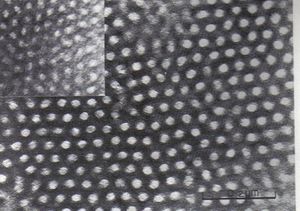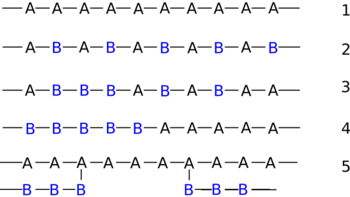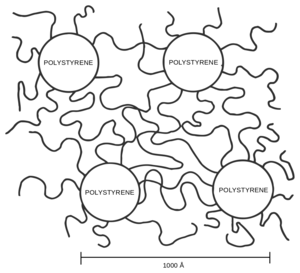پوليمر تساهمي
| علم الپوليمرات |
|---|
ملاحظة: الپوليمرات التساهمية التي نحصل عليها بالبلمرة تساهمية لموحودين تسمى بپوليمر ثنائي، والپوليمر ات التي نحصل عليها من ثلاثة مواحيد تسمى بپوليمر ات ثلاثية، والپوليمر ات التي نحصل عليها من أربعة مواحيد تسمى پوليمر ات رباعية، إلخ[1] ولأن الپوليمرات الثنائية تشكل أكبر مجموعة منها، فإن مصطلح پوليمر تساهمي يطلق أساسًا على هذه المجموعة.[2]
پوليمر تساهمي متناوب: هو پوليمر تساهمي مكون من جزيئات ضخمة تضم نوعين من المواحيد في تسلسل متناوب. ملاحظة: قد يعد البوليمير الإسهامي المتناوب بوليميرًا متجانسًا مشتقًا من موحود ضمني أو افتراضي.[1]
پوليمر تساهمي كتلي: جزء من جزيء ضخم، يضم عدداً من الوحدات البنيوية التي تتسم بميزة واحدة على الأقل، وهي أنها ليست موجودة في الأجزاء المجاورة.[3]
پوليمر تساهمي مطعم: هو جزيء ضخم يكون فيه نوع واحد أو أكثر من الكتل متصلًا بالسلسلة الرئيسية مشكلة سلاسل جانبية، ولهذه السلاسل الجانبية صفات بنيوية وتهايئية (en) مختلفة عن تلك المكونة للسلسة الرئيسية.[4]في كيمياء الپوليمرات، الپوليمرات التساهمية أو الپوليمرات المشتركة [5] أو البوليمرات الإسهامية (Copolymer) هي لپوليمرات تتكون من موحودين أو أكثر متحدين بعملية بلمرة لتشكيل منتج جديد بخصائص جديدة.[2] يسمى الناتج پوليمر تساهمي أو پوليمر إسهامي أو پوليمر مشترك، وتسمى العملية بلمرة مشتركة (أو بلمرة إسهامية). ومن الپوليمرات الإسهامية التجارية پوليمر الأكريلونيتريل بيوتادايين إستيرين (ABS)، والپوليمرات التساهمية ستيرين-بيوتادين (SBR)، ومطاط النتريل، وپوليمر لدينة ستايرين-أكريلونتريل، وبوليمير ستايرين-إيزوبرين-ستايرين (SIS) وپوليمر خلات فاينيل-إيثلين.
أنواع الپوليمرات التساهمية
ولما كان البوليمير الإسهامي يتكون من وحدتين مكونتين على الأقل، يمكن للبوليميرات الإسهامية أن تصنف وفقًا لطريقة ترتيب هذه الوحدات على طول سلسلة البوليمير.[6]. وهذه الأنواع هي:
- بوليمير إسهامي متناوب (Alternating copolymers): تناوب منتظم للوحدات A وB، كما في (2).
- بوليمير إسهامي دوري (Periodic copolymers): الوحدات A وB مرتبة بتسلسل دوري، أي (A-B-A-B-B-A-A-A-A-B-B-B)n
- بوليمير إسهامي إحصائي (Statistical copolymers): هي بوليميرات إسهامية يكون فيها تسلسل الوحدات يتبع قاعدة إحصائية. إذا كانت احتمالية وجود نوع محدد من المواحيد في مكان خاص من السلسلة مساوية للكسر المولي لذلك الموحود في السلسلة، يكون البوليمير إذن بوليميرًا عشوائيًا.[7]، كما في (3).
- بوليمير تساهمي كتلي (Block copolymers): يتكون من جزئين أو أكثر من بوليمير متجانس متصلين ببعضهما بروابط تساهمية، كا في (4). قد يتطلب اتحاد جزئي البوليمير المتجانس جزءًا وسيطًا غير متكرر يعرف باالكتلة الرابطة. البوليميرات الإسهامية الكتلية قد تسمى بوليميرات إسهامية ثنائية الكتلة أو ثلاثية الكتلة وفقًا لعدد الأجزاء الكتلية للبوليمير الإسهامي.
وتوصف البوليميرات الإسهامية إيضًا بوجود تفرعات أو ترتيبها في بنية البوليمير. البوليمير الإسهامي الخطي يتكون من سلسلة رئيسية مفردة في حين أن البوليمير الإسهامي المتفرع يتكون من سلسلة رئيسية مفردة مع وجود سلسلة جانبية واحدة أو أكثر.
ويوجد أنواع خاصة من البوليميرات الإسهامية المتفرعة تتضمن البوليميرات النجمية، والمكنسية، والمشطية، وكلها تصف شكل البوليمير المتشكل. وفي البوليميرات الإسهامية المتدرجة (en) يتغير تركيب الموحود تدريجيًا على طول السلسلة. البوليمير الإسهامي الثلاثي (terpolymer)، هو بوليمير إسهامي يتكون من ثلاثة مواحيد مختلفة. والرباعي من أربعة. ولأن أكبر مجموعة هي بوليميرات ثنائية، فإن مصطلح بوليمر إسهامي يطلق أساسًا على هذه المجموعة.[2]
- بوليمر تساهمي كتلي فراغي (Stereoblock copolymers): هو بوليمر ذو بنية خاصة، يمكن أن يتشكل من موحود واحد، تكون السمة المميزة له هي ترتيبية كل كتلة.
بوليمير تساهمي مُطعّم (Graft copolymers)
نوع خاص من البوليميرات المتفرعة تكون فيها السلاسل الجانبية مميزة بنيويًا عن السلسلة الرئيسية. يصور الشكل في (5) حالة خاصة فيها السلسلة الرئيسية والسلاسل الجانبية مكونة من بوليميرات متجانسة مميزة. وقد تكون السلاسل المفردة للبوليمير الإسهامي المطعم هي بذاتها بوليميرات متجانسة أو إسهامية. لاحظ أن تعاقب البوليمير الإسهامي المختلف هو كاف لتعريف الاختلاف البنيوي. لنفترض أننا نقوم بكوثرة بالجذور الحرة (en) للستايرين بوجود متعدد البيوتادايين، المطاط الاصطناعي، الذي يحمل رابطة ثنائية تفاعلية C=C في المتبقي. سنحصل على سلاسل متعدد الستايرين تنمو في كلا الاتجاهين في بعض الأماكن التي توجد فيها روابط مزدوجة وإعادة ترتيب لذرة كربون واحدة. النتيجة هي سلسلة رئيسية من متعدد الستايرين مع سلاسل متعدد البيوتادايين تنمو منها في الاتجاهين. وهو بوليمير إسهامي مهم يختلف في خصائصه عن مكوناته، فالسلسلة المطاطية ستمتص الطاقة عند الاصطدام، فهي أقل قصافة من متعدد الستايرين التقليدي. يسمى هذا المركب بمتعدد الستايرين المقاوم للصدم.
بوليمر إسهامي كتلي
تتكون البوليميرات الإسهامية من كتل من مواحيد متكوثرة[8]. فمثلًا PS-b-PMMA هو اختصار لـ متعدد الستايرين-ب-متعدد (ميثيل أكريلات الميثيل)[9]، وهو يصنع عادة من بوليمير الستايرين، ثم تضاف أجزاء بوليمير MMA إلى النهايات التفاعلية لسلاسل متعدد الستايرين. هذا البوليمير هو بوليمير إسهامي ثنائي بسبب احتوائه على كتلتين كيميائيتين مختلفتين. ويمكن تصنيع بوليميرات ثلاثية ورباعية ومتعددة الكتل. البوليميرات الإسهامية ثنائية الكتل تصنع باستخدام تقنية الكوثرة الحية (en)، مثل الكوثرة بالجذور الحرة وانتقال الذرة (en)، وكوثرة بانتقال السلسلة وإضافة الأجزاء العكوسة (en)، كوثرة بالتنادل والفتح الحلقي (en)، أو الكوثرة الأنيونية الحية أو الكاتيونية الحية.[10] ويوجد تقنية كوثرة بطريقة مكوك السلسلة (en).[11] التقنية الأقوى لتحضير البوليميرات الإسهامية الكتلية هي اقتران تدريجي انتقائي بين الأصل البوليميري وعوامل الارتباط الوظيفية المغايرة[12].
الپوليمرات التساهمية النجمية
الپوليمرات التساهمية النجمية have several polymer chains connected to a central core.
فصل الطور الدقيق

Block copolymers can "microphase separate" to form periodic nanostructures,[13][14] such as styrene-butadiene-styrene block copolymer. The polymer is known as Kraton and is used for shoe soles and adhesives. Owing to the microfine structure, transmission electron microscope or TEM was used to examine the structure. The butadiene matrix was stained with osmium tetroxide to provide contrast in the image. The material was made by living polymerization so that the blocks are almost monodisperse to create a regular microstructure. The molecular weight of the polystyrene blocks in the main picture is 102,000; the inset picture has a molecular weight of 91,000, producing slightly smaller domains.
Microphase separation is a situation similar to that of oil and water. Oil and water are immiscible (i.e., they can phase separate). Due to the incompatibility between the blocks, block copolymers undergo a similar phase separation. Since the blocks are covalently bonded to each other, they cannot demix macroscopically like water and oil. In "microphase separation," the blocks form nanometer-sized structures. Depending on the relative lengths of each block, several morphologies can be obtained. In diblock copolymers, sufficiently different block lengths lead to nanometer-sized spheres of one block in a matrix of the second (e.g., PMMA in polystyrene). Using less different block lengths, a "hexagonally packed cylinder" geometry can be obtained. Blocks of similar length form layers (often called lamellae in the technical literature). Between the cylindrical and lamellar phase is the gyroid phase. The nanoscale structures created from block copolymers can potentially be used to create devices for computer memory, nanoscale-templating, and nanoscale separations.[15] Block copolymers are sometimes used as a replacement for phospholipids in model lipid bilayers and liposomes for their superior stability and tunability.[16][17]
Polymer scientists use thermodynamics to describe how the different blocks interact.[18][19] The product of the degree of polymerization, n, and the Flory-Huggins interaction parameter, , gives an indication of how incompatible the two blocks are and whether they will microphase separate. For example, a diblock copolymer of symmetric composition will microphase separate if the product is greater than 10.5. If is less than 10.5, the blocks will mix and microphase separation is not observed. The incompatibility between the blocks also affects the solution behavior of these copolymers and their adsorption behavior on various surfaces.[20]
Block copolymers are able to self-assemble in selective solvents to form micelles among other structures.[21]
In thin films, block copolymers are of great interest as masks in the lithographic patterning of semiconductor materials for applications in high density data storage. A key challenge is to minimise the feature size and much research is in progress on this.[22]
التوصيف
Characterization techniques for copolymers are similar to those for other polymeric materials. These techniques can be used to determine the average molecular weight, molecular size, chemical composition, molecular homogeneity, and physiochemical properties of the material.[23] However, given that copolymers are made of base polymer components with heterogeneous properties, this may require multiple characterization techniques to accurately characterize these copolymers.[24]
Spectroscopic techniques, such as nuclear magnetic resonance spectroscopy, infrared spectroscopy, and UV spectroscopy, are often used to identify the molecular structure and chemical composition of copolymers. In particular, NMR can indicate the tacticity and configuration of polymeric chains while IR can identify functional groups attached to the copolymer.
Scattering techniques, such as static light scattering, dynamic light scattering, and small-angle neutron scattering, can determine the molecular size and weight of the synthesized copolymer. Static light scattering and dynamic light scattering use light to determine the average molecular weight and behavior of the copolymer in solution whereas small-angle neutron scattering uses neutrons to determine the molecular weight and chain length. Additionally, x-ray scattering techniques, such as small-angle X-ray scattering (SAXS) can help determine the nanometer morphology and characteristic feature size of a microphase-separated block-copolymer or suspended micelles.[25]
Differential scanning calorimetry is a thermoanalytical technique used to determine the thermal events of the copolymer as a function of temperature.[26] It can indicate when the copolymer is undergoing a phase transition, such as crystallization or melting, by measuring the heat flow required to maintain the material and a reference at a constantly increasing temperature.
Thermogravimetric analysis is another thermoanalytical technique used to access the thermal stability of the copolymer as a function of temperature. This provides information on any changes to the physicochemical properties, such as phase transitions, thermal decompositions, and redox reactions.[27]
Size-exclusion chromatography can separate copolymers with different molecular weights based on their hydrodynamic volume.[28] From there, the molecular weight can be determined by deriving the relationship from its hydrodynamic volume. Larger copolymers tend to elute first as they do not interact with the column as much. The collected material is commonly detected by light scattering methods, a refractometer, or a viscometer to determine the concentration of the eluted copolymer.
التطبيقات
البوليمرات التساهمية الكتلية
A common application of block copolymers is to develop thermoplastic elastomers (TPEs).[23] Early commercial TPEs were developed from polyurethranes (TPUs), consisting of alternating soft segments and hard segments, and are used in automotive bumpers and snowmobile treads.[23] Styrenic TPEs entered the market later, and are used in footwear, bitumen modification, thermoplastic blending, adhesives, and cable insulation and gaskets.[23] Modifying the linkages between the blocks resulted in newer TPEs based on polyesters (TPES) and polyamides (TPAs), used in hose tubing, sport goods, and automotive components.[23]
Amphiphilic block copolymers have the ability to form micelles and nanoparticles.[29] Due to this property, amphiphilic block copolymers have garnered much attention in research on vehicles for drug delivery.[29][30] Similarly, amphiphilic block copolymers can be used for the removal of organic contaminants from water either through micelle formation[23] or film preparation.[31]
البوليمرات التساهمية التبادلية
The styrene-maleic acid (SMA) alternating copolymer displays amphiphilicity depending on pH, allowing it to change conformations in different environments.[32] Some conformations that SMA can take are random coil formation, compact globular formation, micelles, and nanodiscs.[32] SMA has been used as a dispersing agent for dyes and inks, as drug delivery vehicles, and for membrane solubilization.[32]
هندسة البوليمرات التساهمية
Copolymerization is used to modify the properties of manufactured plastics to meet specific needs, for example to reduce crystallinity, modify glass transition temperature, control wetting properties or to improve solubility.[33] It is a way of improving mechanical properties, in a technique known as rubber toughening. Elastomeric phases within a rigid matrix act as crack arrestors, and so increase the energy absorption when the material is impacted for example. Acrylonitrile butadiene styrene is a common example.
انظر أيضاً
الپوليمرات التساهمية المتناوبة
للپوليمرات التساهمية المتناوبة الصيغة التالية: -A-B-A-B-A-B-A-B-A-B-، أو -(-A-B-)n-.
هندسة الپوليمرات التساهمية
انظر أيضاً
المصادر
- ^ أ ب
McNaught, A. D.; Wilkinson, A. (1996). "Glossary of basic terms in polymer science (IUPAC Recommendations 1996)". Pure and Applied Chemistry. 68: 2287–2311. doi:10.1351/goldbook.C01335. خطأ استشهاد: وسم
<ref>غير صالح؛ الاسم "goldbook1996" معرف أكثر من مرة بمحتويات مختلفة. - ^ أ ب ت Encyclopedia Of Textile Finishing,H.K.Rouette,2000,V.1,page.220
- ^ "Glossary of basic terms in polymer science". Pure and Applied Chemistry. 68 (12): 2287–2311. 1996. doi:10.1351/pac199668122287.
- ^ "Glossary of basic terms in polymer science (IUPAC Recommendations 1996)" (PDF). Pure and Applied Chemistry. 68 (12): 2287–2311. 1996. doi:10.1351/pac199668122287.
- ^ ترجمة Copolymer حسب بنك باسم للمصطلحات العلمية؛ مدينة الملك عبد العزيز للعلوم والتقنية، تاريخ الوصول: 05 02 2017.
- ^ Jenkins, A. D.; Kratochvíl, P.; Stepto, R. F. T.; Suter, U. W. (1996). "Glossary of Basic Terms in Polymer Science". Pure Appl. Chem. 68 (12): 2287–2311. doi:10.1351/pac199668122287.
- ^ Painter P. C. and Coleman M. M., Fundamentals of Polymer Science, CRC Press, 1997, p 14.
- ^ مخبر أبحاث البوليميرات (Princeton.edu تاريخ الولوج 15 آب 2008)
- ^ Coustet, Marcos Eduardo (17 March 2014). "Síntesis y propiedades de copolímeros en bloque constituidos por bloques hidrofílico-hidrofóbico": 123. Retrieved 21 April 2014.
{{cite journal}}: Cite journal requires|journal=(help) - ^ Hadjichristidis N., Pispas S., Floudas G. Block copolymers: synthetic strategies, physical properties, and applications – Wiley, 2003.
- ^ Bellas, Vasilios; Rehahn, Matthias (2007). "Universal Methodology for Block Copolymer Synthesis". Macromolecular Rapid Communications. 28 (13): 1415. doi:10.1002/marc.200700127.
- ^ Bellas, Vasilios; Rehahn, Matthias (2009). "Block Copolymer Synthesis via Chemoselective Stepwise Coupling Reactions". Macromolecular Chemistry and Physics. 210 (5): 320. doi:10.1002/macp.200800463.
- ^ Hamley, I.W. "The Physics of Block Copolymers" – Oxford University Press, 1998.
- ^ Hamley, I.W. "Developments in Block Copolymer Science and Technology" – Wiley, 2004.
- ^ Gazit, Oz; Khalfin, Rafail; Cohen, Yachin; Tannenbaum, Rina (2009). "Self-assembled diblock copolymer "nanoreactors" as catalysts for metal nanoparticle synthesis". Journal of Physical Chemistry C. 113 (2): 576–583. doi:10.1021/jp807668h.
- ^ Meier, Wolfgang; Nardin, Corinne; Winterhalter, Mathias (2000-12-15). "Reconstitution of Channel Proteins in (Polymerized) ABA Triblock Copolymer Membranes". Angewandte Chemie International Edition. Wiley. 39 (24): 4599–4602. doi:10.1002/1521-3773(20001215)39:24<4599::aid-anie4599>3.0.co;2-y. ISSN 1433-7851. PMID 11169683.
- ^ Zhang, Xiaoyan; Tanner, Pascal; Graff, Alexandra; Palivan, Cornelia G.; Meier, Wolfgang (2012-03-11). "Mimicking the cell membrane with block copolymer membranes". Journal of Polymer Science Part A: Polymer Chemistry. Wiley. 50 (12): 2293–2318. Bibcode:2012JPoSA..50.2293Z. doi:10.1002/pola.26000. ISSN 0887-624X.
- ^ Bates, Frank S.; Fredrickson, Glenn H. (2014). "Block Copolymer Thermodynamics: Theory and Experiment". Annual Review of Physical Chemistry. 41: 525–557. Bibcode:1990ARPC...41..525B. doi:10.1146/annurev.pc.41.100190.002521. PMID 20462355.
- ^ Chremos, Alexandros; Nikoubashman, Arash; Panagiotopoulos, Athanassios (2014). "Flory-Huggins parameter χ, from binary mixtures of Lennard-Jones particles to block copolymer melts". J. Chem. Phys. 140 (5): 054909. Bibcode:2014JChPh.140e4909C. doi:10.1063/1.4863331. PMID 24511981.
- ^ Hershkovitz, Eli; Tannenbaum, Allen; Tannenbaum, Rina (2008). "Adsorption of block co-polymers from selective solvents on curved surfaces". Macromolecules. 41 (9): 3190–3198. Bibcode:2008MaMol..41.3190H. doi:10.1021/ma702706p. PMC 2957843. PMID 20976029.
- ^ Hamley, I.W. "Block Copolymers in Solution" – Wiley, 2005.
- ^ Hamley, IW (2009). "Ordering in Thin Films of Block Copolymers: Fundamentals to Potential Applications". Progress in Polymer Science. 34 (11): 1161–1210. doi:10.1016/j.progpolymsci.2009.06.003.
- ^ أ ب ت ث ج ح Hadjichristidis, Nikos; Pispas, Stergios; Floudas, George (2002-11-15). Block Copolymers (in الإنجليزية). Hoboken, USA: John Wiley & Sons, Inc. doi:10.1002/0471269808. ISBN 978-0-471-39436-5.
- ^ Rowland, Steven M.; Striegel, André M. (2012-06-05). "Characterization of Copolymers and Blends by Quintuple-Detector Size-Exclusion Chromatography". Analytical Chemistry (in الإنجليزية). 84 (11): 4812–4820. doi:10.1021/ac3003775. ISSN 0003-2700. PMID 22591263.
- ^ Hu, Hanqiong; Gopinadhan, Manesh; Osuji, Chinedum O. (2014-03-21). "Directed self-assembly of block copolymers: a tutorial review of strategies for enabling nanotechnology with soft matter". Soft Matter (in الإنجليزية). 22 (10): 3867–3889. Bibcode:2014SMat...10.3867H. doi:10.1039/C3SM52607K. PMID 24740355.
- ^ Skoog, Douglas A. (1998). Principles of instrumental analysis. F. James Holler, Timothy A. Nieman (5th ed.). Philadelphia: Saunders College Pub. ISBN 0-03-002078-6. OCLC 37866092.
- ^ Coats, A. W.; Redfern, J. P. (1963-01-01). "Thermogravimetric analysis. A review". Analyst (in الإنجليزية). 88 (1053): 906–924. Bibcode:1963Ana....88..906C. doi:10.1039/AN9638800906. ISSN 1364-5528.
- ^ Yamakawa, Hiromi (1971). Modern theory of polymer solutions. New York: Harper & Row. ISBN 0-06-047309-6. OCLC 159244.
- ^ أ ب Cho, Heui Kyoung; Cheong, In Woo; Lee, Jung Min; Kim, Jung Hyun (2010). "Polymeric nanoparticles, micelles and polymersomes from amphiphilic block copolymer". Korean Journal of Chemical Engineering (in الإنجليزية). 27 (3): 731–740. doi:10.1007/s11814-010-0216-5. ISSN 0256-1115. S2CID 95286455.
- ^ Rösler, Annette; Vandermeulen, Guido W. M.; Klok, Harm-Anton (2012-12-01). "Advanced drug delivery devices via self-assembly of amphiphilic block copolymers". Advanced Drug Delivery Reviews. MOST CITED PAPERS IN THE HISTORY OF ADVANCED DRUG DELIVERY REVIEWS: A TRIBUTE TO THE 25TH ANNIVERSARY OF THE JOURNAL (in الإنجليزية). 64: 270–279. doi:10.1016/j.addr.2012.09.026. ISSN 0169-409X.
- ^ Herrera-Morales, Jairo; Turley, Taylor A.; Betancourt-Ponce, Miguel; Nicolau, Eduardo (2019). "Nanocellulose-Block Copolymer Films for the Removal of Emerging Organic Contaminants from Aqueous Solutions". Materials (in الإنجليزية). 12 (2): 230. Bibcode:2019Mate...12..230H. doi:10.3390/ma12020230. ISSN 1996-1944. PMC 6357086. PMID 30641894.
- ^ أ ب ت Huang, Jing; Turner, S. Richard (2017-05-05). "Recent advances in alternating copolymers: The synthesis, modification, and applications of precision polymers". Polymer (in الإنجليزية). 116: 572–586. doi:10.1016/j.polymer.2017.01.020. ISSN 0032-3861.
- ^ Muzammil, Iqbal; Li, Yupeng; Lei, Mingkai (2017). "Tunable wettability and pH-responsiveness of plasma copolymers of acrylic acid and octafluorocyclobutane". Plasma Processes and Polymers. 14 (10) 1700053. doi:10.1002/ppap.201700053. S2CID 104161308.






